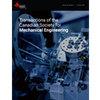考虑时变参数的电力线巡检机器人伺服系统速度控制策略
IF 1
4区 工程技术
Q4 ENGINEERING, MECHANICAL
Transactions of The Canadian Society for Mechanical Engineering
Pub Date : 2023-05-24
DOI:10.1139/tcsme-2022-0123
引用次数: 0
摘要
大多数电力线检测机器人的伺服系统由电机、独立关节和负载组成。在越障过程中,由于姿态的变化,伺服系统参数具有明显的时变特性。动态参数的时变特性和负载的灵活性会导致检测机器人的转速波动,从而影响运动精度。针对比例积分(PI)控制器的参数优化问题,提出了极点配置策略。在不同姿态下选取最优控制器参数,保证检测机器人伺服系统输出稳定的速度。首先,建立了检测机器人伺服系统的动力学方程。在建模过程中考虑了关节柔度和载荷柔度。然后,利用Arnoldi算法对伺服系统进行降阶,得到从速度到驱动转矩的传递函数;其次,采用极点配置法对控制器参数进行优化。通过合理选择极点阻尼系数,可以使检测机器人获得稳定的速度输出。最后,对不同姿态下检测机器人的数值分析和速度控制进行了分析。结果表明,极点放置控制策略可以使检测机器人实现稳定的转速。本文章由计算机程序翻译,如有差异,请以英文原文为准。
Speed control strategy for power line inspection robot servo system considering time-varying parameters
Most servo systems in power line inspection robots consist of a motor, an independent joint, and a load. In the process of crossing obstacles, the parameters in the servo systems have conspicuous time-varying properties due to the posture changes. The time-varying properties of dynamic parameters and the flexibility of the load would cause the rotation speed of the inspection robot to fluctuate, thereby affecting the motion accuracy. In this paper, the pole placement strategy was proposed to optimize the parameters in the proportional integral (PI) controller. The optimal controller parameters were selected in different postures to ensure steady speed output in the inspection robot servo system. First, the dynamic equations of the inspection robot servo system were established. Both joint flexibility and load flexibility were considered in the modeling process. Then, the Arnoldi algorithm was used to reduce the order of the servo system, and the transfer function from the speed to the drive torque was obtained. Next, the controller parameters were optimized using the pole placement method. By reasonably selecting the pole damping coefficient, the inspection robot could obtain a stable speed output. Finally, the numerical analysis and speed control of the inspection robot in different postures were analyzed. The results showed that the control strategy of pole placement could achieve a stable rotation speed for the inspection robot.
求助全文
通过发布文献求助,成功后即可免费获取论文全文。
去求助
来源期刊
CiteScore
2.30
自引率
0.00%
发文量
53
审稿时长
5 months
期刊介绍:
Published since 1972, Transactions of the Canadian Society for Mechanical Engineering is a quarterly journal that publishes comprehensive research articles and notes in the broad field of mechanical engineering. New advances in energy systems, biomechanics, engineering analysis and design, environmental engineering, materials technology, advanced manufacturing, mechatronics, MEMS, nanotechnology, thermo-fluids engineering, and transportation systems are featured.

 求助内容:
求助内容: 应助结果提醒方式:
应助结果提醒方式:


